With nearly 1 in 4 U.S. adults already having a smart speaker in their home, voice assistants and Conversational AI are quickly increasing in popularity in most major markets and becoming a normal part of people’s lives around the world.
Systems like Alexa and Google Home have created a new field of research in cognitive science that examines the effects of conversational devices interacting with users. The widespread availability and increasing adoption rates have also contributed to consumer behavior trends and purchasing patterns — from voice assistants becoming ubiquitous to people spending more on home improvement projects and the growing use of mobile devices as digital assistants.
In this article, we’ll take a deeper look at this field and explore 9 of the most important predictions for the future of voice bots and Conversational AI.
Explore Voice Assistant Use Cases & Examples. This article contains numerous real-life examples of implementing voice assistants, demonstrating their utility for businesses.
Table of Contents
Explaining the Shift Towards Conversational AI and Voice Assistants
The consumer shift to voice, driven by evolving user expectations, is dramatically reshaping customer service. Voice user interfaces (VUIs) offer efficient, natural ways for customers to interact. As people grow more comfortable with real‑time digital conversations, brands have an opportunity to deliver faster responses and higher satisfaction by embracing conversational interfaces.
In fact, the global AI in voice assistants market was valued at $3.54 billion in 2024 and is projected to grow to $4.66 billion in 2026—a 31.5% year‑over‑year increase. This surge underscores why voice assistance is expanding so rapidly. It’s highly likely that almost every app will leverage AI‑based voice tech in some form over the next five years.
By lowering friction and increasing intuitiveness, future voice applications will become not just more responsive, but significantly easier for users to adopt and integrate into daily routines.
Top 10 Insights into the Future of Voice AI and Conversational Assistants
Personalized Experiences
Personalization is more than names at the top of emails, it’s staying in touch with customer tastes and preferences and actively including them in the conversation. Personalization is essential for building meaningful relationships that last. Businesses can use machine learning (ML), in particular, the subset of ML known as Natural Language Processing (NLP) along with Sentiment Analysis to identify the true meaning of customer requests and queries. By identifying the Intents in those requests, brands can generate accurate responses to customers instantaneously.
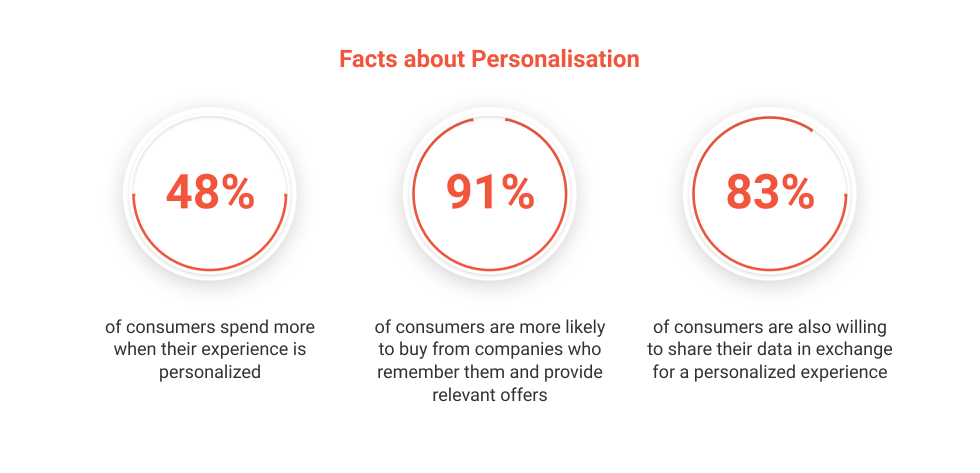
Conversational AI and Customer-Centric Personalization
For example, Pillo health helps users stay on top of their medication — measuring when it should be taken, keeping it stored, and dispensing it at the right time. When a user adds a new medication to their Pillo account, the robot politely reminds them to take it regularly before the date they need to administer it.
Voice Push Notifications
Voice notifications are a valuable tool to engage users within the application and this tendency will keep for the future of voice assistants. Notifications can be helpful in reminders, promotions, and information. 55% to 60% of all mobile users opt into push notifications which means that businesses have a stronger chance of reaching their audience with relevant and timely messages.
Voice assistants are also designed to connect to third-party apps for voice push notifications, for instance, both Google and Alexa have this functionality, allowing them to notify users about everything from calendar appointment reminders to music streaming services.
Search Behavior Will Shift
As adoption rates among online shoppers continue to rise and voice search continues to be at the top of the eCommerce sales funnel, eCommerce sites must ensure that they have the tools necessary to capture information and engage customers. By engaging customers, brands can develop long-lasting relationships with customers. Check out Use Cases of Conversational AI in eCommerce to improve Сustomer Acquisition and increase Sales.
According to Juniper Research, consumers will spend $19 billion on voice-enabled products by 2022. If voice search models are successful enough, this will introduce a new advertising gate for brands that want to keep their messages prominent.
Inbuilt Security Features for Users
The latest trend in the voice assistant market is built‑in security features—designed to reassure users about privacy and data protection. Once again, mega‑corporations like Amazon and Google are leading the charge, rolling out updates such as speaker verification and ID confirmation to ensure only authorized individuals can access sensitive commands or information.
An emerging layer of this protection is voice biometrics—technology that analyzes unique vocal characteristics (like pitch, cadence, and accent) to confirm a user’s identity. This approach not only improves voice authentication accuracy but also enables fraud prevention by flagging suspicious attempts to mimic or spoof a user’s voice. Financial institutions, for instance, are adopting this method to reduce account takeover risks via call centers or smart devices.
To further address privacy concerns, Amazon has published more detailed disclosures about the Echo’s recording capabilities and its data retention policies. Additionally, new features now allow users to delete stored recordings automatically, opt out of certain data uses, and ensure that personal information is never stored locally on the device.
Voice Assistance in Mobile Apps
Apps with integrated AI voice assistants have improved usability and make app navigation easier. With voice-activated apps, users can control nearly all of an app’s functionality through voice commands. In many ways, this is similar to text-based chatbots or GUI-based conversational agents that allow users to navigate enter websites through a single element in the website. But, voice-based navigation is even faster and easier. This is a game-changer for end-users who are less tech-savvy and want to use apps while spending less time and energy.
Voice Commerce
Voice commerce is quickly emerging as one of the most practical and revenue‑driving applications of conversational AI. By enabling voice‑enabled checkout, shoppers can complete purchases hands‑free in seconds—without the friction of typing, tapping, or filling out long forms. This level of convenience is especially appealing for mobile users and smart speaker owners, where speed is key.
Retailers are also leveraging cart reminders triggered by voice assistants, prompting customers about items left in their carts and even offering time‑sensitive discounts to encourage checkout. Combined with personalized product discovery, where a voice assistant suggests relevant items based on browsing history, purchase behavior, and even contextual data like season or location, voice commerce transforms casual browsing into completed sales.
For brands, this means higher conversion rates, reduced cart abandonment, and a more seamless omnichannel shopping experience. As adoption grows, integrating voice into the e‑commerce journey will shift from novelty to necessity.
Inbound Calls and Smart IVR with a Natural Language Understanding (NLU) Feature
An advanced Interactive Voice Response (IVR) and a call tracking system can significantly improve sales and customer satisfaction, and even more provide call center automation. Businesses can use an intelligent virtual agent powered by an NLP engine to answer customers’ questions in real-time or create outbound calls with the click of a button. A smart call tracking system integrated into a business’ IVR lets them monitor and record every phone call from prospects or customers, creating robust data that can be used to generate outbound sales campaigns.
Increased visibility into your leads and contacts will give you a brand-new approach to sales, allowing you to optimize efforts immediately — giving your business a competitive advantage and improving overall performance.
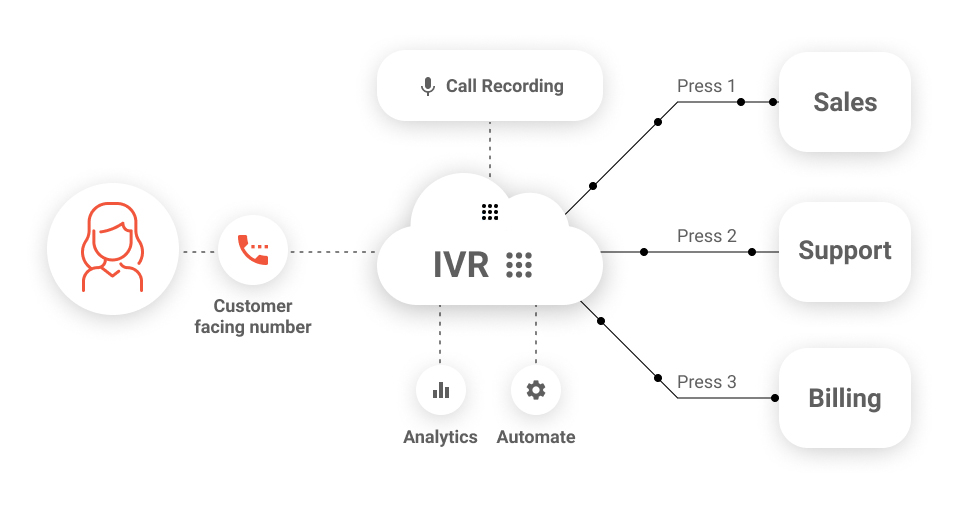
Conversational AI in Video Game Narratives
When mentioning Conversational AI’s use in gaming, we can’t ignore the importance of text-to-speech as well as voice recognition in creating a more immersive gaming experience. This is not an easy feat, especially when considering the vast possibilities of different types of voices, including synthetic voices and generative neural networks.
That said, generative neural networks are machine learning tools that are making this possible. Developers can create dynamic verbal dialogue for video games with far less manual labor.
As neural networks and artificial intelligence engines become more advanced, game designers can create NPCs with current voice-acting tools and use them to create a more immersive storyline. The next innovations in AI engines will allow bots to develop a custom personality based on player action, producing more realistic conversations. The NPC responds according to how the player has acted throughout the game. Considering that video games have become the biggest sector in the entertainment industry, it’s promising to see voice technology being a core part of its innovations.
Voice Cloning
Voice cloning is a process that uses machine learning along with neural networks to generate realistic human speech Neural network-based text-to-speech platforms mimic how the brain functions to process language and exhibit outstanding efficiency at learning patterns in data.
Deep learning comes into play when it’s time to generate human-like speech and is particularly effective at capturing nuances such as speed and intonation.
Through the power of artificial intelligence, deep neural networks, and cloud-based GPUs, new startups can create a computerized voice that modifies your own and make it indistinguishable from the voice of a natural person. Voice cloning will certainly be one of the biggest drivers in the entertainment industry, very similar to early CGI. The realistic nature of voice cloning is already creating a buzz in Hollywood. To a lesser extent, voice cloning may see consumer uses, especially in privacy-focused online communities.
The Rise of Enterprise Voice Assistants and Chatbots
Brands like Starbucks, Spotify, and eBay have built intelligent customer service into their online presence. One of the most innovative chatbots is the Bank of America’s Announcement bot by the name of Erica. Erica uses artificial intelligence, algorithms, predictive messaging, and many other advanced techniques to help customers make payments, check balances, and new products.
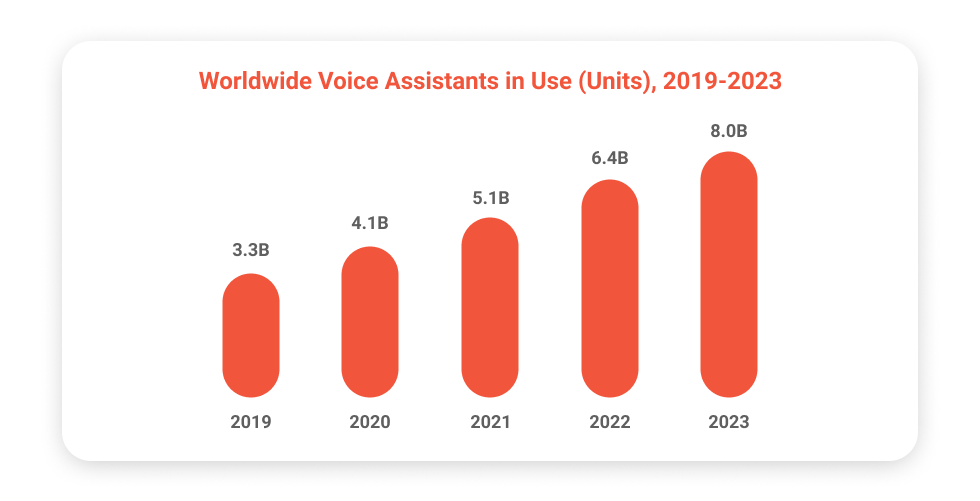
Worldwide Voice Assistants in Use (Units), 2019-2023
On the other hand, Amazon voice assistant continues to extend its lead over the competition by announcing its Alexa Skills and Alexa Capabilities. Amongst other new features, Amazon has given developers the tools to build their own Alexa skills (apps) — a unique feature that’s not available on any other device.
Some ideas for using Alexa skills include: improving the user experience, providing information, and improving productivity. For instance, a customer can experience a new product through Alexa’s customer-centric approach — with questions like “Alexa, how is this product made?”
Integration of Large Language Models (LLMs) in Voice Assistants and Speech AI Technologies
Voice Assistants and speech AI technologies are evolving to leverage the capabilities of Large Language Models (LLMs). These LLMs have the potential to enhance call summaries, improve real-time translation, provide valuable cues for sales and support teams during ongoing conversations, and automate repetitive tasks in a more natural and less robotic manner. As LLMs gain prominence, we can anticipate the integration of their expanded capabilities into both speech AI technologies and Voice Assistants.
Now is the time to develop immersive and engaging experiences that incorporate Voice Assistants. How soon can we expect these experiences to be widely embraced? According to Opus Research survey, 13% of respondents believe that widespread adoption is already occurring, while 72% anticipate that voice-enabled experiences will become widely adopted within the next one to five years. In simpler terms, we can confidently expect these experiences to become commonplace before the end of this decade.
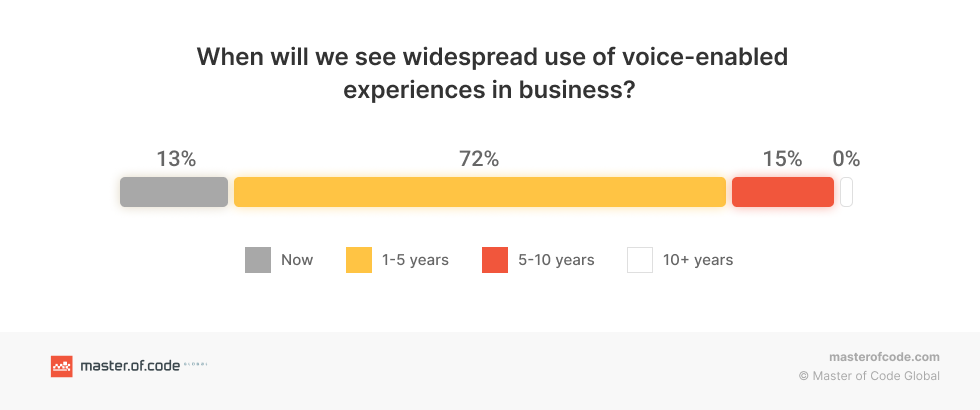
Given the progress we have witnessed in Conversational AI, facilitated by the emergence of Large Language Models such as OpenAI’s ChatGPT, the era of voice-enabled technology may arrive sooner than expected. When questioned about the timeline for Voice Assistants to achieve human-like levels of interaction, 43% of respondents indicated that this milestone would be reached within a year, while 54% estimated that human-like AI voice assistant are just one to three years away.
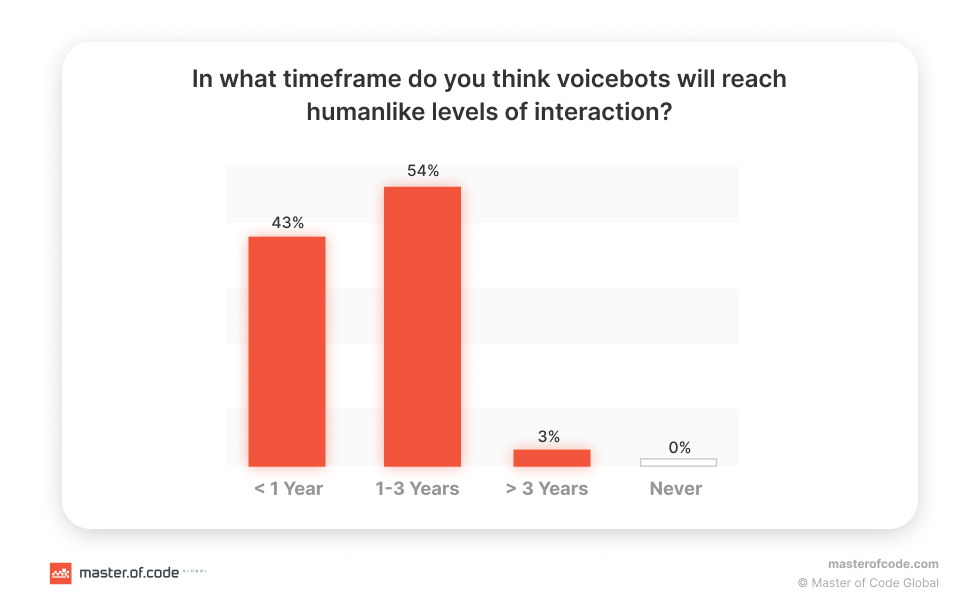
This highlights the enduring potential of LLMs across the entire language technology spectrum, spanning from advanced models operating on powerful cloud-based supercomputers to potentially becoming an integral part of smartphone operating systems in the near future. It underscores the ongoing significance of LLMs and their integration with Voice Assistants at different levels of language technology.
The latest advancements in Large Language Models are poised to enhance the current state-of-the-art, offering users increasingly immersive and interactive experiences facilitated by Voice Assistants. With the introduction of OpenAI’s released GPT-4 model, a wide range of possibilities arises for leveraging LLMs in the field of voice technology. Enhancements in Large Language Models have the potential to enhance the accuracy of speech-to-text systems by comprehending context and predicting likely phrases or sentences. This leads to more precise transcriptions of spoken language, benefiting applications such as Voice Assistants, transcription services, and voice commands.
Dialogue systems rely on LLMs as a critical component, enabling Chatbots and Voice Assistants to understand user inputs, maintain context, and generate coherent and relevant responses. This technology finds application in various domains, including Generative AI in customer service, eCommerce, personal assistants, and more.
Voice AI Across Industries: Where It’s Making the Biggest Impact
Healthcare Voice Assistants
In healthcare, voice assistants are moving far beyond appointment booking. Virtual nursing assistants now provide 24/7 support, guiding patients through medication schedules, post‑treatment care, and symptom tracking. This is especially valuable for chronic disease management, where consistent monitoring and timely reminders can significantly improve outcomes. For instance, a patient with diabetes might receive daily voice prompts to log blood sugar levels, which are instantly shared with a care team. Patient self‑service portals with voice navigation also reduce administrative burdens by letting individuals check lab results, schedule follow‑ups, or get answers to common questions without waiting for a live agent.
Education & Personalized Tutoring
Voice AI is reshaping the classroom and the study session alike. Personalized tutoring systems adapt to each learner’s pace, offering targeted explanations when a concept proves challenging. Microlearning modules deliver quick, focused lessons—perfect for students preparing for tests or learning on the go. Voice assistants also excel at homework assistance, providing instant clarifications, step‑by‑step solutions, or even interactive quizzes to reinforce comprehension. Importantly, they enhance accessibility for students with disabilities, enabling hands‑free navigation, real‑time transcription, or audio descriptions that create a more inclusive learning environment.
Finance Voice Assistants
In the finance sector, voice assistants are becoming indispensable for delivering fast, secure, and personalized service. Customers can check balances, transfer funds, or pay bills simply by speaking, while voice authentication ensures that sensitive transactions remain protected. Beyond basic tasks, these assistants can act as proactive financial advisors, analyzing spending patterns to recommend budgeting strategies, alerting users about unusual account activity, or offering investment insights tailored to personal risk tolerance. This shift reduces reliance on in‑branch visits while keeping users engaged with their finances in real time.
Automotive Applications
The automotive industry is embracing voice AI to make driving safer and more intuitive. In‑vehicle assistants allow drivers to control navigation, climate, and infotainment systems without taking their hands off the wheel. For fleet management, voice interfaces simplify logging driver activity, scheduling maintenance, and receiving operational updates. Safety is another key benefit—voice systems can detect fatigue in a driver’s speech, suggest rest breaks, warn about traffic hazards, or automatically contact emergency services. As vehicles grow more connected, these assistants will integrate with broader mobility ecosystems, personalizing routes, entertainment, and vehicle performance settings based on driver preferences.
Beyond the vehicle itself, a voice assistant for dealership is becoming a critical touchpoint across the automotive customer journey — from answering inbound sales calls to booking test drives, qualifying leads, and scheduling service appointments. This creates a seamless bridge between in-car experiences and dealership operations, improving conversion rates and customer satisfaction.
Challenges of Future of AI Assistants
AI voice bot solutions have improved at communicating with humans across a range of situations. However, voice recognition and natural language understanding aren’t perfect and there is still room to improve. For now, experts are innovating to combat a few key challenges, including:
- Future of Voice Recognition
Although voice recognition has advanced in leaps and bounds, AI still needs to continue improving – especially at recognizing minorities, as AI voice assistants today are disproportionately better at recognizing white male voices. Rather than a technological flaw, this is an indication of the lack of sample data that AI models can be trained against. Additionally, inputs that are not appropriately processed can lead to frustration and a loss of customer trust across the board. To ensure a better experience, it is essential to develop AI that recognizes different dialects, accents, background noises, slang, and even nicknames. - Cybersecurity Concerns
The key to success with any conversational AI app is building trust and confidence among end-users. End-users can have high-security protocols, and despite recent advancements in privacy and security, privacy concerns are still present. - Apprehensive Users
One of the early expectations from voice assistants was that it would be the younger millennials and Gen Z accepting voice assistants the most. However, the older generations (ages 55 and above) seem to like the idea of voice assistants more than the younger generation. According to a survey by Think with Google, the adoption rates for voice-activated speakers are surging among baby boomers. Google found that 51% of Baby Boomers use voice assistants as an informative companion and not just as a tool to play music or make a quick shopping list.Furthermore, as employees begin using voice-based automation in their workplace, they far likely to adopt the same technologies in their homes and personal lives. Therefore, It’s important to understand that customer hesitation doesn’t reflect poorly on your brand. Instead, it is an indication of the voice technology gap that is getting smaller every year.
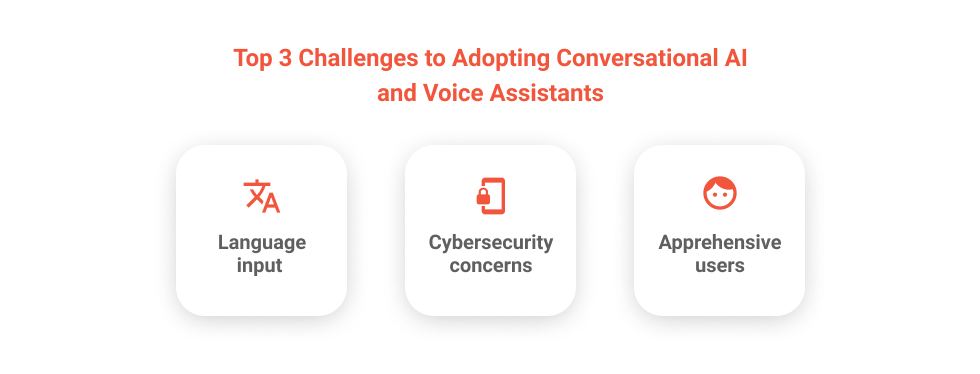
Future Trends in Voice AI
The future of conversational AI, and particularly voice assistants is very bright. About 60 percent of smartphone users have tried voice search at least once in the 12 months; while they might not engage with it every day, they are beginning to see the convenience and accessibility it offers. By 2024, the global voice-based smart speaker market could be worth $30 billion, which is another indication of the vast market of voice assistants. But with every untapped opportunity comes a ticking clock, to capitalize on it before it loses its competitive advantage. With these 9 top predictions for voice assistants, we’ve tried to help businesses like yours find the right opportunity in this promising new world of voice assistants.
However, if you’re unsure of how to proceed with developing and deploying voice assistants of your own, consulting with an expert like Master of Code Global is the best way to go.
Let us help you connect your brand with customers where they communicate today. Chat or voice.






